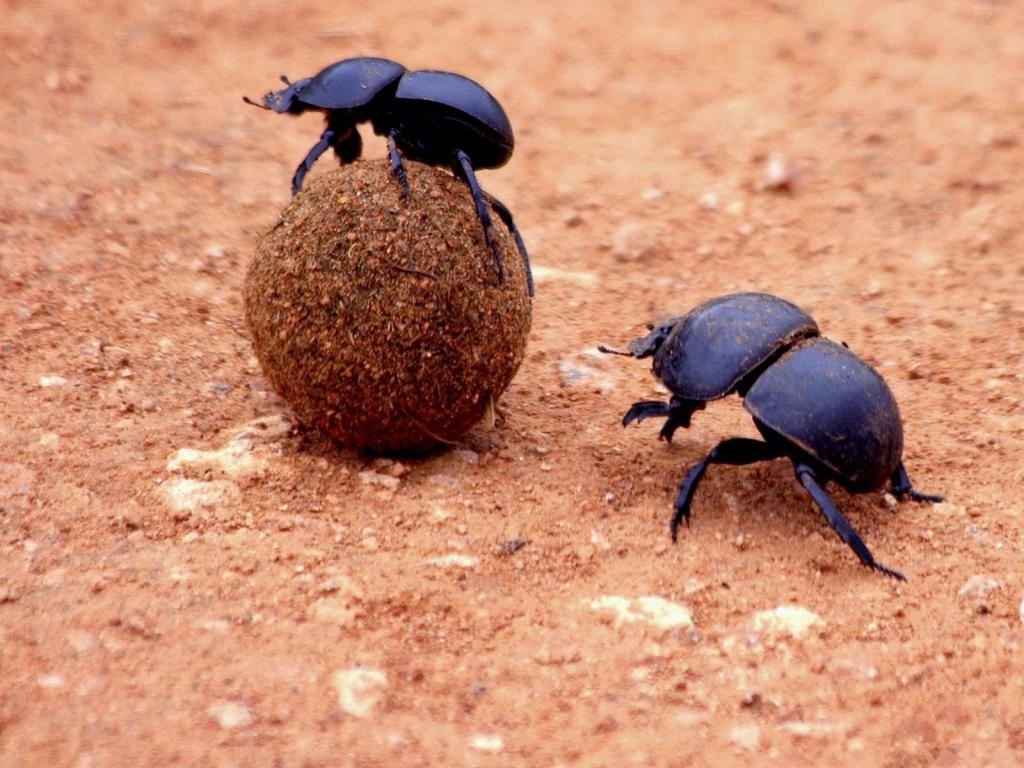
Reproduction
The
Scarabaeus sacers’ life cycle revolves around its reproduction
cycle. They are mainly located in costal sub regions where they
are submerged in the sand (Lobo et al. 2001). In the beginning
of spring the adult S. sacer emerge to reproduce. Their main
focus when emerging is to feed to mature their gonads (Halffter
et al. 2011). They then fly to locate theri food source, which
is the dung of cows, sheep, or
 similar animals; they then fly to locate their food source
(Halffter et al. 2011). If it is a smaller amount of dung, like
from a sheep, the beetle uses its middle or hind legs to roll
one or several pellets while it pulls other dung pellets
towards itself using its front legs, all of which are made into
one larger ball (Halffter et al. 2011). If the amount of dung is
larger, the beetle will use its clypeus (front of head) and
forelegs to cut away pieces of dung and then push it under their
body (Halffter et al. 2011).
similar animals; they then fly to locate their food source
(Halffter et al. 2011). If it is a smaller amount of dung, like
from a sheep, the beetle uses its middle or hind legs to roll
one or several pellets while it pulls other dung pellets
towards itself using its front legs, all of which are made into
one larger ball (Halffter et al. 2011). If the amount of dung is
larger, the beetle will use its clypeus (front of head) and
forelegs to cut away pieces of dung and then push it under their
body (Halffter et al. 2011).
After obtaining
their food, the S. sacers’ next goal is to push the ball of dung back
to their nest (no farther than 3 cm) for mating and a food resource
(Halffter et al. 2011). Sometimes the male and female will push the
dung ball back to their nest individually, but it is much more common
for the female and male to work together (Halffter et al. 2011). If
the male and female are working together the male will generally
push and the female will pull (Halffter et al. 2011).
A large factor that
is important during the relocation of the dung is fighting; it can
be used as a form of sexual selection (Halffter et al. 2011). Males
will generally fight over dung balls and females will follow
wherever the ball of dung goes (Halffter et al. 2011). The dung
balls can generally be given to a female as a gift (Halffter et al.
2011). If a female is rolling the ball she will fight other females
for the dung ball. If she is rolling it by herself and a male shows
up he will finish rolling the ball and she will follow (Halffter et
al. 2011). The attacker generally tries to climb
on top of the ball, while the owner defends it and they fight by
striking each other with their anterior tibia(Halffter et al.
2011).
When the dung ball
is brought to the nest, the couple both buries the ball where the
mating then occurs (Halffter et al. 2011). Mating happens on the
surface of the dung. (Halffter et al. 2011).
After mating, the male will surface from the dung and then search
for a new female to mate with while the original female stays in the dung
and feeds on it. (Halffter et al. 2011). Along with feeding on the
dung, the female will transform the ball into an ovoid shape and
builds a chamber for the egg and oviposits (lays egg) in it. Once
the egg is laid, the female will abandon the nest (Halffter et al.
2011).